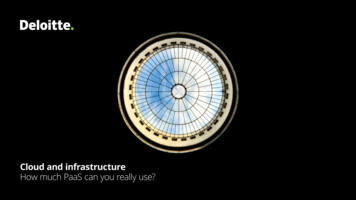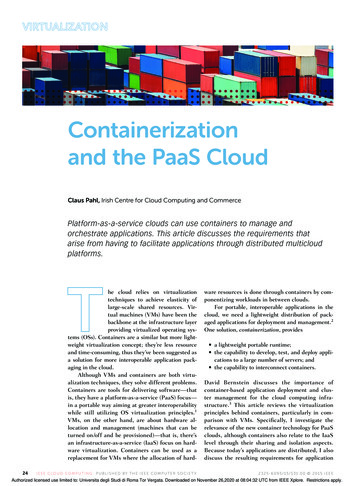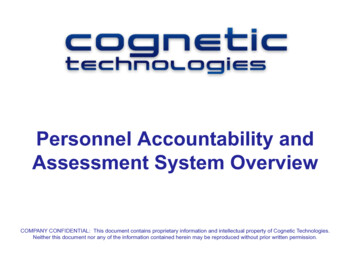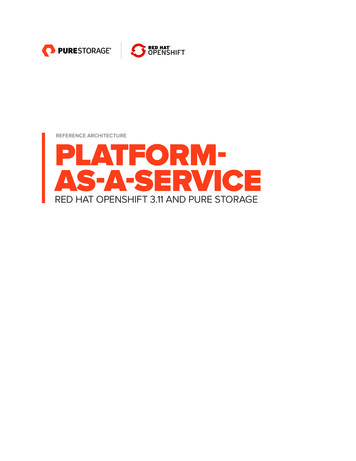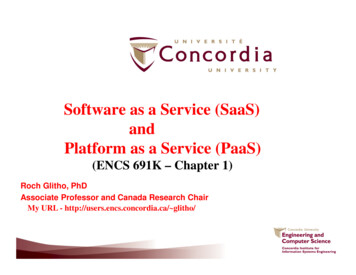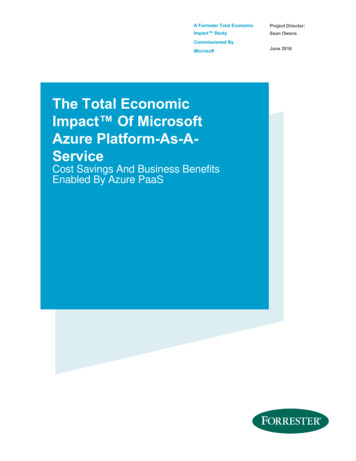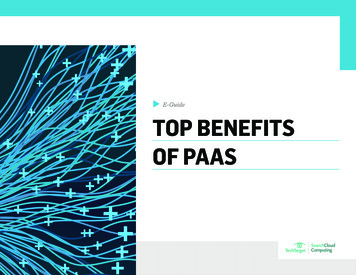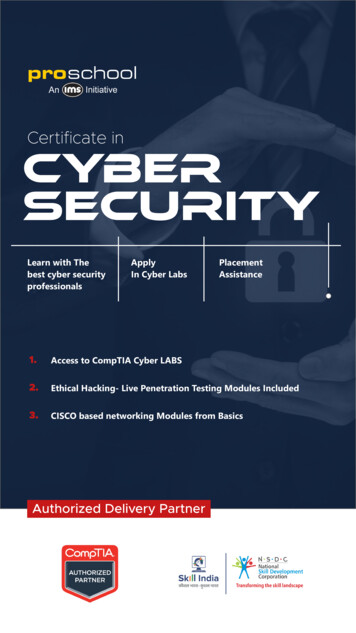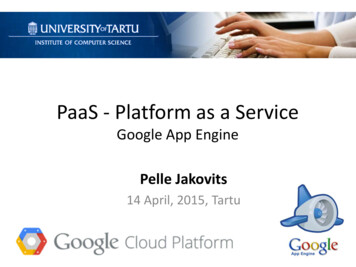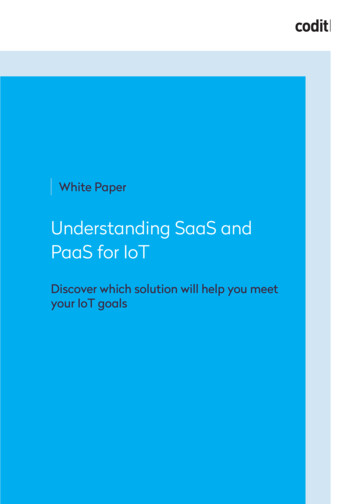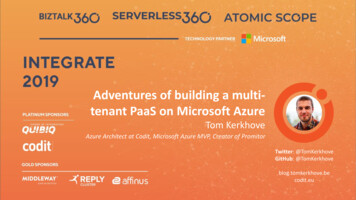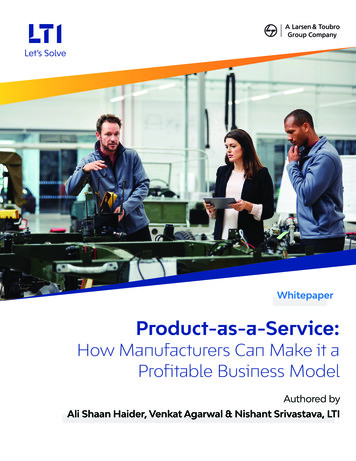
Transcription
WhitepaperProduct-as-a-Service:How Manufacturers Can Make it aProfitable Business ModelAuthored byAli Shaan Haider, Venkat Agarwal & Nishant Srivastava, LTI
Introduction: Product-as-a-Service, or ServitizationDid you know you can buy tyres on the promise of number ofmiles they can run? Or that Airlines companies pay for enginesbased on utilization in air? Or that elevators you use are provisionedto buildings based on number of trips (up and down) they do?These are some examples of providing Product as a Service,where companies manufacturing these assets have switched theCapital Expenditure (CAPEX) model to an Operational Expenditure(OPEX) model.Michelin Tyres, Rolls Royce and Otis Elevator are the companiesmentioned above.Product-as-a-Service (PaaS) is a concept where the value oroutcomes the product provides are monetized instead of themaintenance service revenue which would have otherwise gone toproduct itself. In this scenario the product is owned by theindependent maintenance companies that the customer could havemanufacturer and the output of the product is purchased by thedirectly engaged.client through a differentiated commercial construct. For example,when Otis Elevator sells “Vertical Transportation as a Service”,PaaS model however is not new. Michelin Tyres delivered PaaSthe maintenance and repair activities for the elevator is fullythrough its Fleet Solutions offering in 2001. What has made thisowned by the manufacturer. This has a great implication for themodel more relevant today, is the declining commercial costs ofmanufacturer and the customer of the manufacturer. On onetechnology that delivers this model. In the era of digitalization,hand the liability of performance shifts from the customer to thePaaS has emerged as a powerful concept for manufacturers tomanufacturer and on the other hand the manufacturer can protectdifferentiate their offerings.Why the need to shift?When the model came into being, the following benefits were observed for the stakeholders:For manufacturers1) In product selling model, the revenue is irregular based on the amount of sales which can vary on season, amount of sales etc., whereasPaaS model ensures a regularized revenue stream2) The product usage is monitored regularly in PaaS by manufacturers and they are better equipped than customers to use the productsmore effectively3) The aftersales market or the service market is rather unexplored by most firms and there is a huge potential to delve into services to realizemore value from a product4) The touchpoints for customer in the earlier model is limited till the sale of product, whereas the customer touchpoints are higher in PaaSmodel. This gives an opportunity for the firm to perceive pain points for customer and innovate their products faster.5) By knowing what works and what does not and what the customers value, the manufacturers create a feedback loop in their designprocess direct from their observations
For customers1) They do not have to deal with maintenance cost and management of their assets thereby they can focus on other business processesdelivering consumer satisfaction2) It helps them make supplier their trusted partners which shifts the responsibility of smoother running of operations towards suppliers. In thismanner supplier can have their own responsibility in delivering value to consumers at their end in a B2B2C model.3) The capital expenses for the customers is not all upfront rather they have a steadier cash outflow for a period, thereby they can manage theirfinances better.4) Customers if unsure about the manufacturer’s product can employ the services for a shorter duration and then can extend the contract orsearch for other options depending on whether the service is satisfactory to their requirement or not.Key focus areas that can be targeted in PaaSThere is a lot of literature that has been written about differentdispatch systems will be key to ensure smoother operations. Thisaspects that enable PaaS. Most of these revolve around technologycapability also ties the other elements that enable the PaaS journey.bucketed under the Industry 4.0 concepts; elements like IoT andHowever, because a lot has been written on this subject already, wesensors to collect data from the assets, ability to transform this datachose to focus on other aspects. To gain more insights on thisinto valuable insights as well as about the need to change behavioursubject please follow the link to Powering the Servitization ofinternally and externally. However, in our experiences with our clientsManufacturing with Industry 4.0 from references below.and through our research, there are still gaps that need to beplugged. If you look closely at the opportunity here, it is amonetization problem that companies try to solve for theircustomers. All companies have the same technology access, yetRelated Readingsome succeed, and some do not. We believe that the core of thePowering the Servitization of Manufacturing withsuccess lies in the ability of a company to bring different elementsIndustry 4.0(technologies and processes) together and the ability to experiment.Laying the Course for an Inclusive Industry 4.0The core capabilities needed to deliver PaaS model:Transformation Journey1. Connected ProductsInternet of Things and Customer RelationshipBecause PaaS model is a commercial construct, it can be enabled forany kind of product, however we have observed that companiesthat produce products that have sensor capabilities (either retrofit orpre-fit) have a distinct advantage and will give manufacturer theability to provide Connected Products.With connected products, the sole ownership moves to themanufacturer and it becomes imperative for them to have thepooled data of their assets for smarter decision making, efficientutilization and maximizing the value while leasing their products.Using sensors to access real time data should be one of the keyfactors for a firm that is planning to shift to a PaaS model. Predictivedata analytics on IOT platform and automation of scheduling &Management
4. Bring focus on creating a joint task force from across2) Lifecycle costing expertisebusiness functionsMany industrial manufacturing companies who had a deeper look inPaaS as a new business model have realized that it is not easy toprovide this new model to each of their customers in a profitableway for all their product lines. The model switch has an impact onmost lines of businesses of the company and requires changes alongthe entire value chain, mainly across marketing, sales, service, R&Dand design. Further, the model switch will also have an impact oncash flows and how companies invest in future growth.3) Improved field and service care centerFor PaaS to be successful, manufacturers must pay special attentionon the channels that enhance customer engagements. This meansan increased reliance on field services and customer care. To enablethis technology must be relied upon:1. Digital Field Service Management Packages can be employed forThis necessitates a need to do comprehensive scenario planning. Inour experience, most companies do this in some manner or form,however it is the maturity of the process and the ability to work withdata in a comprehensive manner that will ensure success.manufacturingclientbuiltinhousethat2. AI on the Edge so that when data indicates a possible failure, anauto adjustment of operational parameters can be triggered whilethe integration with company’s backend systems and automationOne of our teams has been working with such a tool that a largeindustrialIntelligent Process Automationenablescan help create the maintenance work orders necessary3. Since manufacturing company is aiming to provide a ‘Service’,commercial offer calculation for the services business. The tool wasthere will most likely be a need to invest in customer experiencebasically a set of Excel Macros written in a software form. While thismanagement, now usually a part of most good CRM applicationscould be a good start, the ‘make to order’ business has highly4. Finally, we have not seen a manufacturing organization yet thatcomplex BOMs and even more complex maintenance contracts. Tohas maintenance centers in all the geographies they sell theirmove to PaaS model the solution needs to accumulate vast amountproducts in. They rely heavily on local partnerships and alliancesof data from various aspects of the value chain, like R&D, design,with specific maintenance companies to service their customers.operations, logistics, resources, financials, regulatory requirementsThis element is a very crucial piece of the puzzle. Having a 3-sidedetc to calculate a projected costs over long service period. Now addplatform that allows collaboration between the customer, thethe complexity of IoT data that Connected Products will be providingservice partner and the company is extremely critical. Think howand the fluctuating costs of raw materials and tracking competitoryou can enable an “Airbnb”, “Google Home” or “Apple IOS”movements – both locally and internationally – while aligning pricingplatform for your business when thinking of a closedstrategies for different life cycle stages, and the scenario simulations3-sided platform.needed become unmanageable for such a homegrown solution.Product-as-a-Service complicates revenue and profit growth tied toTo enable the above four, the CIO, CTO and Commercial Teams willtraditional processes and sales approaches such as cost-plus pricing.need to collaborate.If you are evaluating this deep into costs then it is our assumptionyou have already done the Willingness to Pay (WTP) talk with your4) Efficient contract managementcustomers. By combining the WTP and Lifecycle cost data you are ina better position to arrive at what products can be offered in PaaSThose experimenting with PaaS for the first time, must understandmodel, at what price and where the costs need to be optimized tothe implications of the contract they sign with their customers.arrive at the right price. Big Data analytics on performance ofService Contracts are very different from traditional productproducts, their usage and other attributes will ensure improved totalcontracts. You cannot sell and walk away. You have to pay specialcost of ownership for both customers and manufacturers.attention to “what if” scenarios. As mentioned above PaaS getsyou out of a vendor mode & into a partner mode. Further, if someTo be able to do this well, technology teams can do a few things:1. Invest in a proper CPQ and Revenue Management Solution2. Unbundle the traditional application landscape by relooking atyour integration landscape3. Invest in power of Data on Cloud and build applications on top ofyour dataelements have not been done correctly you are directly impactingthe running of operations of your customer and this will impactyour future with them. Further, you have to protect yourself andthe financial interests of your company. Because you may beexperimenting for the first time with this model, you need to havepossibilities for eventual risk management. This makes it necessary to
onboard a modern contract management solution. The Digitalabout transparency in the contractual system of an organizationContract Management system comes into play in this case. The twoallowing them to keep all the bottlenecks in check as well as themajor benefits of Digital Contract Management are:milestone dates. The archived information from older contracts can also be used in drawing up terms of new contract.Managing and delivery of multi-year partnerships – efficientlyorganizes and archives contract sharing within an organization toSmart contracts can also be employed to ramp up speed andprovide a more holistic view in carrying out the budgeting. Digitalsecurity of a contracts management system to make it morecontracts also make the company more agile as it automatesefficient. One of our clients has moved to Blockchain based smartredundant activities to significantly speeds up business processes. contracts and has onboarded their customer, service partners andManaging and controlling long term risks and exposure – bringsfinancial institutes on this journey.The foundation elements of PaaS model?While the above are 4 key “Whats” that need to be considered, there are multiple foundational technology elements that will ensure the “Whats” getdelivered. The below picture gives a diagrammatic view of the PaaS model elements you may need to have. You may have invested in some of thetracks already and in that case it will be important to bring all the elements together to deliver a comprehensive PaaS offering to your customers. OneMove from AssetSelling to ServiceAsset bundle SellingProduct-as-a-Service(PaaS)IntelligentCRM ManagementSupplierMarketplaceScalableStorage &ComputeWorkflowAutomationSmart Contracts betweenpartners, clients and youImplementModernRevenue &CPQ SystemCloudAdoptionFocus onIntegration &Adotion ofAPIsDataManagementLayerIoT/Big ulesContinuous multi-disciplinary Biz team alignmentDevelop a3-sidedPlatformAI on the EdgeRobotics & AutomationFoundationalTechnology LayerWHATConnected Lifecycle ImprovedProductscosting field serviceexpertiseandcare centreEdgeAdoptionHOWStart with WhyWHYkey element that you need to pay special attention is Integration. Integration is a IT foundation that if ignored will ensure failure.
How to shift from Product-selling to PaaS model?Shifting from a product-selling to a PaaS model is not an easy task for a firm. To make the necessary transformation, following understanding andchanges may be required at a firm’s end:1. Understand customer needsIt is essential for a firm to understand what their customer desires interms of output from the product. For example: ‘Packsize’ providedpacking solutions to its customers. However, they noticed that theircustomer often came up with the complaint that the standard sizedboxes provided by them used excess corrugated material consumption than the size of the items, thereby leaving a large amount ofwasteful space while shipping. Thus, Packsize came up with aninteresting idea of offering packaging machine to customer free ofcost and charging only for z-fold corrugated material used inpackaging. This entire exercise claimed has saved around 35% of thecost of packaging and shipping to their customer.2) Support from businessIt is essential for a business to employ a business lead that is going totransform the way they do their business. The organization structurewould be affected while making this change while new modules inERP will be required to reinforce the change. Staffs need to beretrained and marketing strategies need to be revised when theswitch finally happens.3) Technological supportHuge technological support is required for firms in transformingtheir business model. Sensorization of assets to host them onIOT platform. Extensive use of data analytics to be employed togenerate customer insights and differentiate products, serviceofferings and pricing. Cloud adoption and comprehensive servicetechnology (modern service modules) need to be adopted tosupplement the changes.
ConclusionBased on a study by Business Innovation Observatory, the European market for maintenance, repair and operations is estimated to grow by 33 billionEUR in the next 5 years and the margins on services is expected to be 10.7 percent higher than margin of the products, which makes it appealing formanufacturing firms. A survey by Oxford Economics predicted that service contracts strategy will be having a growth rate of 60 percent in the next3 years. The potential for PaaS model is huge in the near future which is why some of the manufacturing firm has already started experimenting withit already. Besides the above mentioned examples, Rolls Royce, Caterpillar, Alstom and Xerox are few other firms that have already experimented withthis model in recent past.Studies show that around 75% of industrial engineering firms are targeting to deliver services as their primary business model in the coming years asthey look to generate new revenue streams. At its core it is a commercial model powered by technology that has become highly affordable. To makethis model successful, it is important to focus on more than just IOT. As explained through the paper our clients who have seen success have lookedat this opportunity more holistically and have tied different technology enablers aggressively. That said, the need to experiment still exists and scalingwhere it is commercially viable is .com/about-the-book/Service and predictive maintenance contracts: Servitisation Business Innovation Observatory
About the authorsAli Shaan HaiderConsultant, Digital Consulting & Advisory, LTIAli is responsible for assisting clients in transforming their processes and operations through digital interventions.He has rich experience that spans Project Management, Planning & Strategy Formulation, Execution, BusinessExcellence & Operational Excellence.Venkat AgarwalAccount Director, LTI NordicsVenkat has 14 years of experience in business partnering, technology advisory & IT. He has worked with clientsacross Manufacturing, Energy, Retail and Wholesale industries and has a foundation in customer success, analyticsand digital strategies. He is an engineering graduate with a Post Graduate Diploma in Digital Business.Nishant SrivastavaConsultant, Digital Consulting & Advisory, LTINishant has around 8 years of experience across Manufacturing and Information Technology, and has beenassisting clients in various programs towards Business Transformation, Data strategy, Process excellence & Supplychain. He has worked with variety of organization from small industrial manufacturer to a large scaleconglomerate. He holds master degree in business from IIM Calcutta.LTI (NSE: LTI, BSE: 540005) is a global technology consulting and digital solutions Company helping more than 420 clients succeed in a convergingworld. With operations in 32 countries, we go the extra mile for our clients and accelerate their digital transformation with LTI’s Mosaic platformenabling their mobile, social, analytics, IoT and cloud journeys. Founded in 1997 as a subsidiary of Larsen & Toubro Limited, our unique heritage givesus unrivaled real-world expertise to solve the most complex challenges of enterprises across all industries. Each day, our team of more than 30,000LTItes enable our clients to improve the effectiveness of their business and technology operations, and deliver value to their customers, employeesand shareholders.Find more at www.Lntinfotech.com or follow us at @LTI Globalinfo@Lntinfotech.com
PaaS model ensures a regularized revenue stream 2) The product usage is monitored regularly in PaaS by manufacturers and they are better equipped than customers to use the products more effectively 3) The aftersales market or the service market is rather unexplored by most firms and there is a huge potential to delve into services to realize
